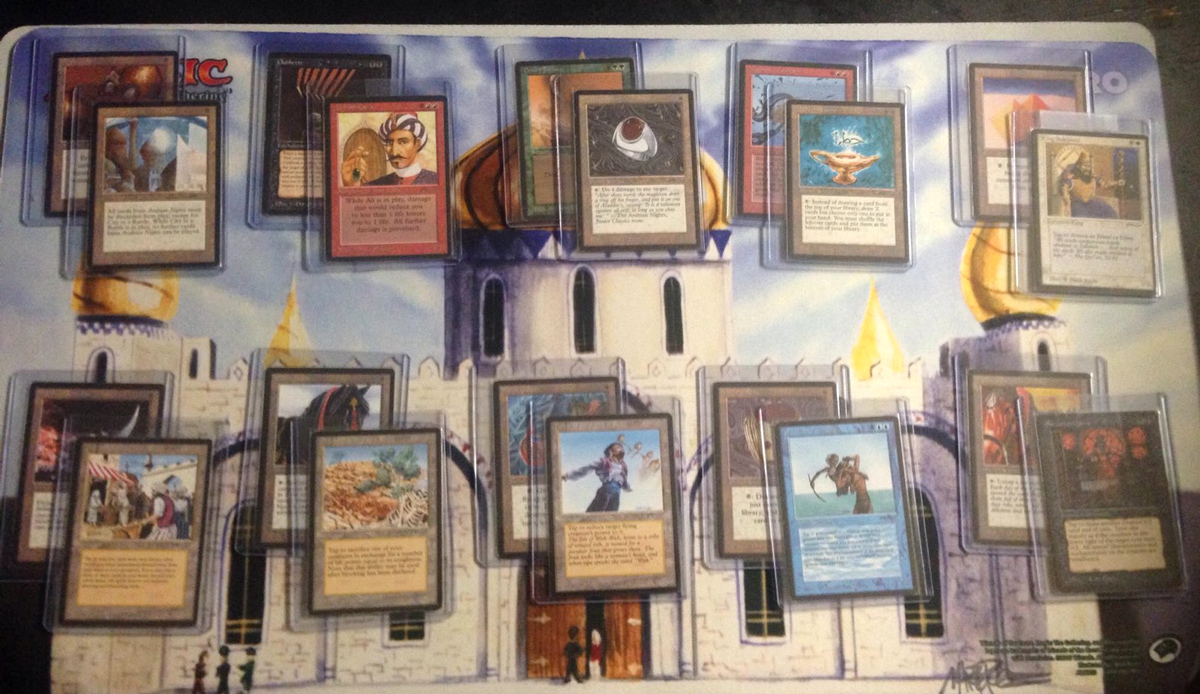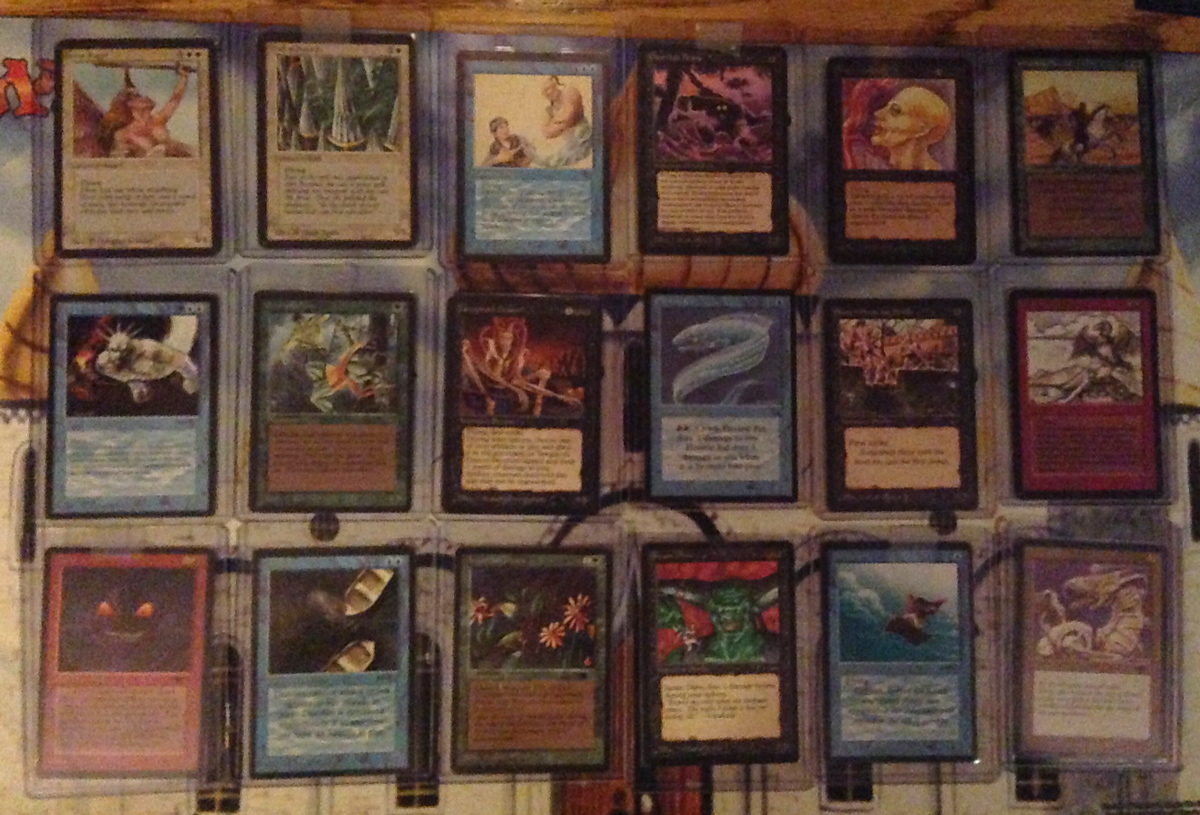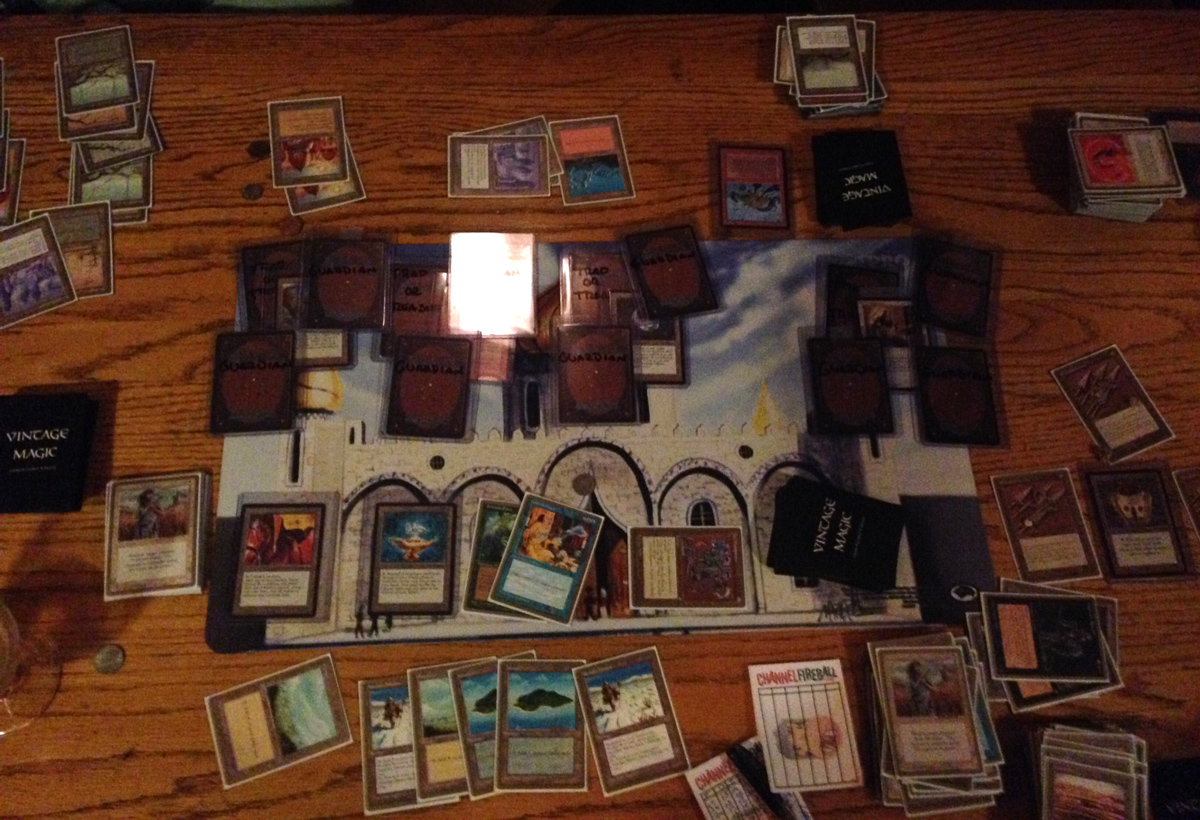Motivated by circumstances I can no longer recall, I was browsing older Magic periodicals on eBay last summer when I encountered an expensive issue of Inquest I thought might be intriguing. On a lark, I purchased the issue using the ‘buy it now’ function. Reading through these magazines – especially when factory sealed – is like being transported decades in to the past. From the editorials to the advertisements, the magazine is a time capsule of opinions and style. It’s a portal to an era largely before the widespread use of the Internet, with a bit of gossip, a dash of humor, and whoosh of zeitgeist.
Case in point: when the issue arrived, I tore off the cellophane wrapping, and flipped to an opening editorial by Michael Searle, featured a photo caption of a chimpanzee holding a playing card at a table, in front of a deck. The editorial demanded that the DCI ban Channel, in a bemused style, saying “I love cheeseheads. Cheeseheads think a theme deck is a decision between Fireballs or Disintegrates; they confusing winning with fun. I guess hitting someone with a 19-point Fireball is fun to some folks – but not me, nor anyone with whom I play Magic.”
Flipping past a profile and interview with ‘moody’ artist Anson Maddocks, and a tongue-in-cheek “Casting Call” feature for a Magic movie (which included Patrick Stewart as the Prodigal Sorcerer), my eyes practically popped out of my head when they fell upon the “Djinn-Efreet War: A New Variant for the Oldest Magic Expansion,” by Michael Serle. If the title didn’t already grab my attention, the beautiful feature layout certainly did, with a game board interlacing article text, and full of my favorite cards from my favorite expansion set.
DjinnEfreetWarGameVariant
My excitement outraced my cognitive powers. I struggled to actually read the brief 3-page article because I was more focused on discovering whether I had the cards on hand to play it, or whether I needed to scavenge for missing parts. Cash left my bank account faster than a White Castle hamburger through my innards before I had even finished reading the feature, but a dozen Uncommon 1s from Arabian Nights were on their way.
The Djinn-Efreet War, Original Set Up
In the original game set up from the article, the basic rules are as follows. The Djinn-Efreet War is a multiplayer, Emperor Magic variant, where the main objective is to reach 10 Victory points, at which point a team wins the game. A team can also win the game by eliminating every player from the opposing team. For those of you unfamiliar with Emperor, the basic concept is that two teams sit across from each other, with the Emperor in the middle on each side, flanked by two Generals. Under Emperor rules, each player can only attack or target a player that is adjacent to them. Thus, Emperors are buffered by their Generals.
How do you get Victory points? That’s the key to this variant. It’s pretty simple really. If you eliminate an Emperor, that’s 3 points. A General is worth 2 points. But your team can also gain Victory points by securing a “Resource.” What is a Resource, and how do you get it?
In the middle of the board, there are 12 “Resources,” which are nothing less than cool Arabian Nights cards. The Resources are: City in a Bottle, Ali from Cairo, Aladdin’s Ring, Ring of Ma’ruf, King Suleiman, Bazaar of Baghdad, Diamond Valley, Island of Wak-Wak, Library of Alexandria, Aladdin’s Lamp, Old Man of the Sea, and Sorceress Queen.
You can secure these Resources by attacking them. If you secure them, you can acquire them, and once you do, they enter play under your control immediately. But getting them is not quite that easy. To secure a Resource, you have to get through a Guardian (or three). A Guardian is a creature that protects the resource from your attack, and who must be overcome in order to secure the resource and earn Victory points.
In a scaling manner, the number of Guardians protecting each resource is equal to the number of Victory points earned by acquiring it. According to the rules presented in the Inquest article, King Suleiman is worth 3 Victory points, and guarded by three Guardians. Aladdin’s Ring, Ali from Cairo, City in a Bottle and Ring of Ma’ruf are all worth 2 Victory points each, and each are guarded by 2 guardians. And Aladdin’s Lamp, Bazaar of Baghdad, Diamond Valley, Island of Wak-Wak, Library of Alexandria, Old Man of the Sea, and Sorceress Queen are all worth 1 Victory point each, and each are guarded by one Guardian.
But that’s not all! Face down below each Resource, and hidden from view, are “Traps” and “Treasures.” Once you secure a Resource by defeating its guardians, you spring a trap or gain a treasure. Treasures, like Resources, enter play immediately under your control. Traps, however, are controlled by your opponents to choose how it affects your team.
What are the Traps and what are the Treasures? The article instructs that the Treasures are the 9 remaining artifacts from Arabian Nights (aside from Jeweled Bird): Bottle of Suleiman, Brass Man, Dancing Scimitar, Ebony Horse, Flying Carpet, Jandor’s Ring, Jandor’s Saddlebags, Pyramids, and Sandals of Abdallah.
For the “Traps,” the article suggests, but does not require, Oubliette, Desert Twister, and Magnetic Mountain. So, 75% of the cards under the resources are Treasures, but 25% are Traps. If you spring the Desert Twister trap, for example, the opposing team decides what to use it on. This may seem a bit complicated, but it’s all really simple. You attack Resources, battle Guardians, and win Treasures or spring Traps.

The article recommends that this format be played entirely with Arabian Nights and Revised cards. That includes the decks that players use and the Guardians that are selected to protect the Resources. Their “sample” Guardians are: Air Elemental, Bog Wraith, Earth Elemental, Fire Elemental, Frozen Shade, Giant Spider, Juggernaut, Mahamoti Djinn, Mesa Pegasus, Savannah Lions, Scryb Sprites, Sea Serpent, Sengir Vampire, Serra Angel, Shivan Dragon, War Mammoth, Water Elemental, and White Knight.
Under the suggested rules, Guardians block all attackers, regardless of evasion abilities, and the opposing team can distribute the Guardians’ damage on their behalf, including using their mana to pump or boost the Guardians. Also, critically, if an attacker and Guardian are both killed in combat, the resource is not claimed and secured until a surviving attacker can do so. It “lies open” for another player to take. Finally, the rules state that Guardians and Resources are not considered “in play” except during combat, and are therefore unaffected by general effects such as Wrath of God or Earthquake.
Adjustments and Refinements
I loved the concept, but had little idea whether it would work and whether it would be fun. I invited some Bay Area Old School players to the Albatross Pub in Berkeley to find out. But first I needed to think about some aspects of the setup through, more carefully. The format seemed fun, but I wanted to make it more exciting. And there were a number of ambiguities to work through.
First of all, I decided to power up the Guardians. Instead of simply using Revised creatures, I wanted the Guardians to be the coolest cards from the early sets. I wanted cards that were more aesthetically pleasing and fun to look at. And I wanted creatures that had abilities that would create more game play. After combing through my collection and Old School sets, I decided to employ the services of these Guardians:

Although not strictly from Alpha or Arabian Nights, I felt that cards like Whirling Dervish, Dragon Engine, Electric Eel, Argothian Pixies, and Atog would improve the format by allowing opposing teams to manipulate them advantageously, or by creating more interesting combat scenarios.
Part of the challenge with such a format is balancing the power level of the Guardians with the creatures available. I thought through some options: asking people to bring regular Old School decks, or preconstructing decks for others to play. The problem with having people prebuild decks is that I’d have to explain the format to them, and I wanted to keep it as mysterious as possible for maximum fun. Some folks might otherwise show up with decks poorly suited to the format. I was pondering this question when I spotted up on a shelf the 1996 Pro Tour Collector’s Set of 8 decks that I bought for myself for Christmas the previous year. I pulled the box down, opened up the decks, and began looking over them. “This could work,” I thought.
The creatures were large and powerful, and many of them were Old School favorites like Erhnam Djinn, Hypnotic Specter, and Serra Angel. The decks were strategically diverse, from extreme control to weenie aggro to midrange, and even a Necropotence deck among them. None of the decks had Power, since they were Type 2 decks, but they had common Type 1 cards like Balance, Strip Mine, Icy Manipulator, and Mishra’s Factory. They were as Type 1 as a Type 2 deck can get. With the power level of these creatures in mind, I finished my selection of Guardians.
I tried to make sure that, at least most of the time, the attackers would have a good chance of killing Guardians. This solved multiple problems: 1) it allowed me to calibrate the balance of power among the player’s decks and the guardians, 2) avoided the headache and hassle of having players build their own decks in advance, and 3) guaranteed strategic diversity among the players.
Conveniently, the PT NY decks have a “checklist” card for each deck so players can quickly peruse the decks. To solve the problem of deck selection, I decided that we would draft decks. After selecting the Emperors randomly, the Emperors would draft the first two decks, followed by their Generals. With 6 players, there would be at least 3 deck options for the last player drafting. Perfect!
I planned to hand out 8 decklist cards around so that players could familiarize with the decks before drafting. Once having drafted the decks, I would further let players ‘pre-sideboard’ before the game. The PT NY decks have a “SB” imprint for all sideboard cards, so it would easy to de-sideboard after the game.
After ruminating on it, I decided – to maximize excitement – that I would deviate from the rules set out in 1995: I would also have Guardians face down, like morph creatures, and flip only when attacked. The reason for this is that I wanted players to get maximum enjoyment out of the surprise of seeing cool Old School cards like Juzam Djinn or my Alpha Serra Angel. I felt that this would lead to more aggressive play, and less calculated maneuvers when trying to secure a resource, and I was right. Players were more aggressive, and were surprisingly well rewarded! In practice, resources were secured very quickly.
There was just one ambiguity: the rules set out by Michael Serle said that Guardians are only “in play” during combat. That would suggest that you could target them with Swords to Plowshares or Lightning Bolt during combat. But that seemed inconsistent with the spirit of the rules, which emphasized that you needed to defeat Guardians in combat. Technically, you can defeat guardians in combat with removal and damage.
Since we were using Type II decks, I felt that the game would be more fun, and Resources easier to acquire, if we allowed Guardians to be targeted with spells during combat, so I decided to allow that.
Game Night
On September 28 2017, five other Old School players trekked to the Albatross Pub in Berkeley to join me for this intriguing experiment: Brian Hanlon, Dustin Espersen, Galen Lemei, Eliot Davidoff, and Hampton Maxwell (who was a last minute substitute for a player who fell ill).

Dustin Espersen got the highest roll, and was Emperor 1. I was second highest, so I was Emperor 2. After consulting with his team (Brian and Hampton), Dustin selected Eric Tam’s Green-White-Red deck, while I drafted Shawn “the Hammer” Regnier’s heavily controlling Blue-White deck, with its many defensive capabilities. Dustin’s Generals drafted the Bertrand Lestree’s Green-White ErhnamGeddon deck and George Baxter’s Black-Red-Green aggro deck. My team’s Generals drafted Preston Poulter’s Green-White ErhnamGeddon deck and Leon Lindbäck’s Mono Black Necropotence deck.
Game play unfolded quickly, and players sought out resources even faster than I expected. Library of Alexandria as a 1 point resource made it a quick target. I think I actually got pretty close to a perfect mixture of small and large creatures, vis-a-vis the threats in the preconstructed decks.
What was surprising was how useful and fun the Arabian treasures and resources were. Aladdin’s Lamp was really powerful. Even Jandor’s Ring was good for Galen when he had Necropotence in play. These cards scaled well with the preconstructed decks we used. This also shows how cool the basic design of the format was.
The Generals on each end skirmished each other, while Dustin and I tried our best to reinforce them. Using my control deck, I established a strong defensive position.

Across from me, Dustin developed more quickly, and attacked the Resources with the same speed. Galen’s Necro deck, however, was the fastest of all, and was able to develop both his board and secure Resources faster than anyone. My left General, Eliot, wore down Hampton, and then we focused our attention on Brian, but we won enough Victory points to win the game before killing Brian.
Looking back, the biggest point of contention was definitely the Emperor rules. Hampton was the first player eliminated, and loudly questioned whether we should permit global effects, the scope of attack and target range, etc. These criticisms in particular, although expected, were not entirely unjustified. Balance, Wrath of God, and Armageddon had outsized effects on the game, and could interfere with the dynamic of battling Guardians.
In the end, everyone felt that it was an excitement experiment, and worth trying again. There were many ideas about how to do so, such as highlander decks, or even other options, such as specially designed constructed decks with strict parameters. Each option has advantages and disadvantages, and perhaps hinges on how much players really enjoy the Pro Tour decks. For my part, I think that the Pro Tour decks are just interesting enough to use, especially when you get so much more flavor and game play from the cards in the center of the board.
Conclusion
This is a format that I would greatly enjoy playing again. What makes it so much fun is that it introduces a way to bring cards in to game play that are outside of the game in a meaningful sense. Because most constructed Magic formats are determined by what players bring with them, this offers a way to bring novel and unusual tactics and effects, both because of the resources, but also because of the treasures and traps. I could easily see this concept being used in other context with other sets.
The Old School overlay, however, really gives it a compelling veneer, and was, for me, the main attraction. I hope to try it again soon!
Until next time,
Stephen Menendian

